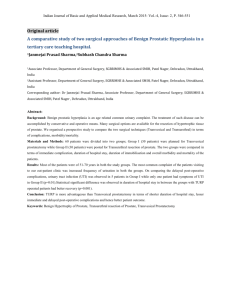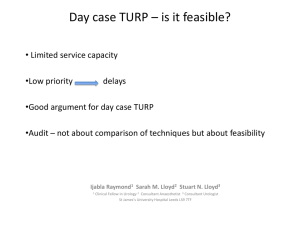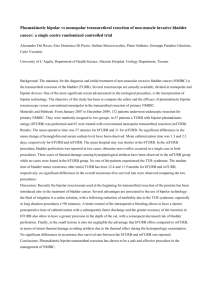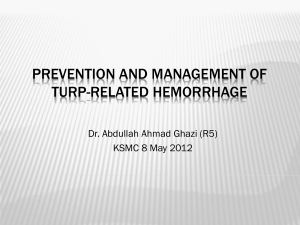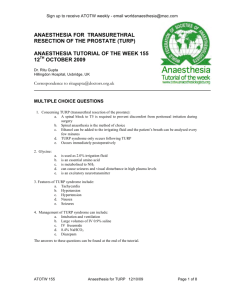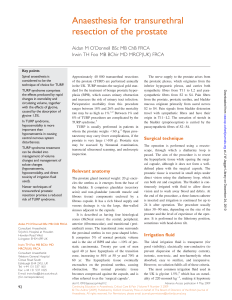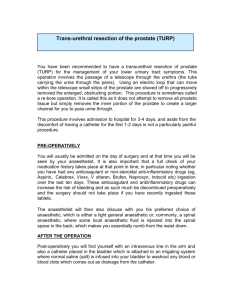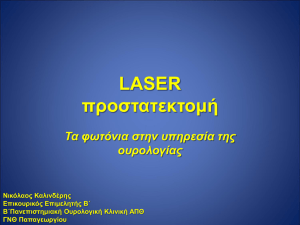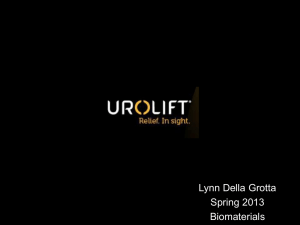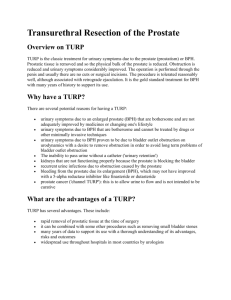A RANDOMIZED COMPARATIVE EFFECTIVENESS TRIAL ON
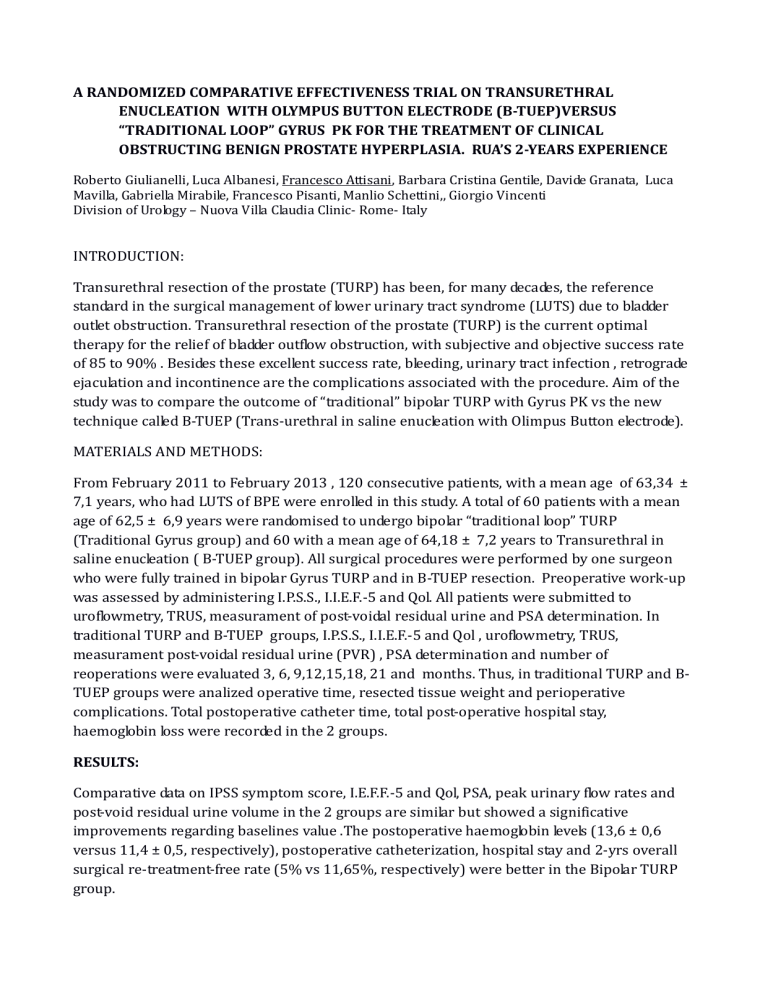
A RANDOMIZED COMPARATIVE EFFECTIVENESS TRIAL ON TRANSURETHRAL
ENUCLEATION WITH OLYMPUS BUTTON ELECTRODE (B-TUEP)VERSUS
“TRADITIONAL LOOP” GYRUS PK FOR THE TREATMENT OF CLINICAL
OBSTRUCTING BENIGN PROSTATE HYPERPLASIA. RUA’S 2-YEARS EXPERIENCE
Roberto Giulianelli, Luca Albanesi, Francesco Attisani, Barbara Cristina Gentile, Davide Granata, Luca
Mavilla, Gabriella Mirabile, Francesco Pisanti, Manlio Schettini,, Giorgio Vincenti
Division of Urology – Nuova Villa Claudia Clinic- Rome- Italy
INTRODUCTION:
Transurethral resection of the prostate (TURP) has been, for many decades, the reference standard in the surgical management of lower urinary tract syndrome (LUTS) due to bladder outlet obstruction. Transurethral resection of the prostate (TURP) is the current optimal therapy for the relief of bladder outflow obstruction, with subjective and objective success rate of 85 to 90% . Besides these excellent success rate, bleeding, urinary tract infection , retrograde ejaculation and incontinence are the complications associated with the procedure. Aim of the study was to compare the outcome of “traditional” bipolar TURP with Gyrus PK vs the new technique called B-TUEP (Trans-urethral in saline enucleation with Olimpus Button electrode).
MATERIALS AND METHODS:
From February 2011 to February 2013 , 120 consecutive patients, with a mean age of 63,34 ±
7,1 years, who had LUTS of BPE were enrolled in this study. A total of 60 patients with a mean age of 62,5 ± 6,9 years were randomised to undergo bipolar “traditional loop” TURP
(Traditional Gyrus group) and 60 with a mean age of 64,18 ± 7,2 years to Transurethral in saline enucleation ( B-TUEP group). All surgical procedures were performed by one surgeon who were fully trained in bipolar Gyrus TURP and in B-TUEP resection. Preoperative work-up was assessed by administering I.P.S.S., I.I.E.F.-5 and Qol. All patients were submitted to uroflowmetry, TRUS, measurament of post-voidal residual urine and PSA determination. In traditional TURP and B-TUEP groups, I.P.S.S., I.I.E.F.-5 and Qol , uroflowmetry, TRUS, measurament post-voidal residual urine (PVR) , PSA determination and number of reoperations were evaluated 3, 6, 9,12,15,18, 21 and months. Thus, in traditional TURP and B-
TUEP groups were analized operative time, resected tissue weight and perioperative complications. Total postoperative catheter time, total post-operative hospital stay, haemoglobin loss were recorded in the 2 groups.
RESULTS:
Comparative data on IPSS symptom score, I.E.F.F.-5 and Qol, PSA, peak urinary flow rates and post-void residual urine volume in the 2 groups are similar but showed a significative improvements regarding baselines value .The postoperative haemoglobin levels (13,6 ± 0,6 versus 11,4 ± 0,5, respectively), postoperative catheterization, hospital stay and 2-yrs overall surgical re-treatment-free rate (5% vs 11,65%, respectively) were better in the Bipolar TURP group.
DISCUSSION:
B-TUEP has a comparable outcome to Bipolar “traditional” TURP at short and medium term to subjective and objective outcome measures. Its impact on bladder outlet function is also similar to that of Bipolar “traditional” TURP.
CONCLUSIONS:
Improvement in I.-P.S.S. , Qol index, I.E.E.F.-5, Qmax and post-void residual urine volume were comparable in both group denoting similar efficacy of the techniques.
